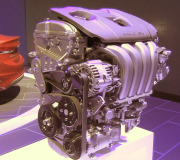Carburettor Synchronisation
1. Start and warm engine to normal operating temperature. On 2.0L engine with automatic transaxle, remove air filter from frequency solenoid valve "C" and plug the opening. See Fig. 3. With engine idling under no load condition, lower idle speed as much as possible by turning throttle stop screw.
2. Adjust idle speed to 550-650 RPM by turning idle control screw. Turn headlights and rear defroster on, and set heater blower switch to maximum output. Adjust idle speed to 550-650 RPM by turning adjusting screw on controller linkage. Turn accessories off.
3. With engine idling under no load condition, turn A/C on. Adjust idle speed to 650-750 RPM by turning adjusting screw on controller motor. Turn A/C off and recheck idle speed. Adjust idle speed to 650-750 RPM (600-700 RPM on High Altitude) by turning throttle stop screw.
4. On all other models, disconnect and plug vacuum hose from intake air control diaphragm. Connect tachometer and observe idle speed with all electrical accessories off, including electric cooling fan. Keep front wheels in straight-ahead position on models with power steering.
5. If necessary, adjust idle speed to specification by turning throttle stop screw. If idle speed is extremely high, check dashpot system. On automatic transaxle models, disconnect hose from frequency solenoid valve "A" and connect it to bottom port of air control valve "A". (Both components must be removed on Prelude). See Fig. 4.
6. Disconnect air cleaner intake tube form air duct. Insert propane hose 4" onto air intake tube. With engine idling, slowly open propane control valve to obtain maximum engine speed.
7. If engine speed increases to enriched RPM, proceed to step 15). If engine speed does not increase, close propane control valve and remove air cleaner.
8. On 2.0L engine, disconnect vacuum hose to fast idle unloader. Pull throttle cable out of bracket. Remove carburetor nuts and washers, and bolt securing steel vacuum manifold. Lift carburetor clear of studs and tilt it backward. Remove throttle opener bracket screw and bracket. See Fig. 5.
9. Remove mixture adjusting screw hole cap from behind throttle opener bracket. Reinstall bracket and reinstall carburetor on engine. Reconnect vacuum hose to fast idle unloader.
10. On 1.8L engine, drain coolant and remove carburetors as follows: Remove two 10 mm bolts under air cleaner base. Remove nuts from air screens and flanges. Remove air cleaner base.
11. Label and disconnect all vacuum hoses and lines from carburetors. Disconnect throttle cable and vacuum hose from throttle opener diaphragm. Disconnect automatic choke lead. Remove carburetors.
12. Place a drill stop on a 1/8" drill bit (1/8" from end). Drill through center of mixture screw hole plug. Screw a sheet metal screw into hole. Grab head of screw with a pair of pliers and remove hole plug.
13. On 1.8L and 2.0L, install carburetors in reverse order of removal and replace coolant, if required. Install air cleaner. Start engine and warm to normal operating temperature. Disconnect and plug vacuum hose from intake air control diaphragm. Reconnect propane enrichment equipment. Recheck maximum propane enriched RPM.
14. If enriched RPM is low, lean out mixture by turning mixture screw clockwise 1/4 turn and recheck RPM. If enriched RPM is high, enrich mixture by turning mixture screw counterclockwise 1/4 turn and recheck RPM.
15. Close propane control valve and recheck idle speed. Run engine at 2500 RPM for 10 seconds to stabilize mixture. Repeat procedure until idle RPM and enriched RPM are correct. Remove propane enrichment kit. Reconnect air cleaner intake tube.
16. Remove carburetor from engine. Remove throttle opener bracket and install mixture adjusting screw hole cap. Reinstall throttle opener bracket on carburetor. Reinstall carburetor on engine and reconnect all vacuum hoses. Check idle-up speed.
Images (Click to make bigger)
Monday, January 2nd, 2012 AT 8:19 PM






